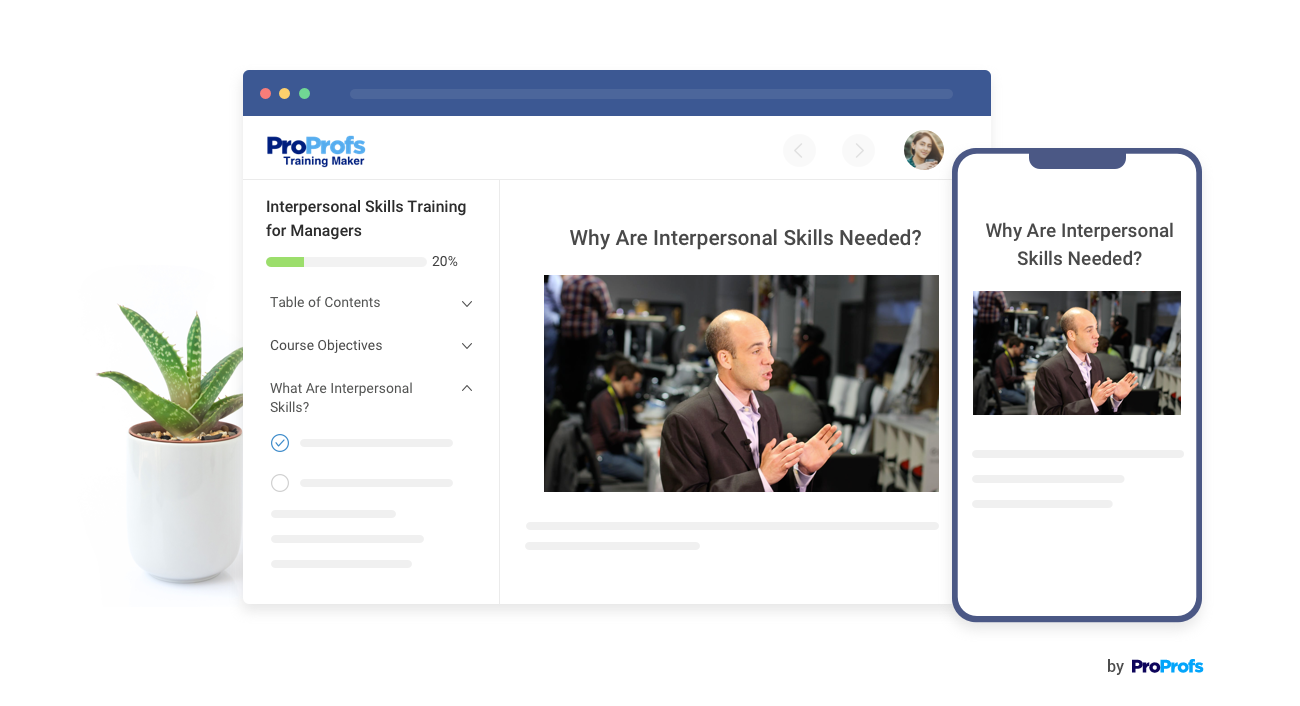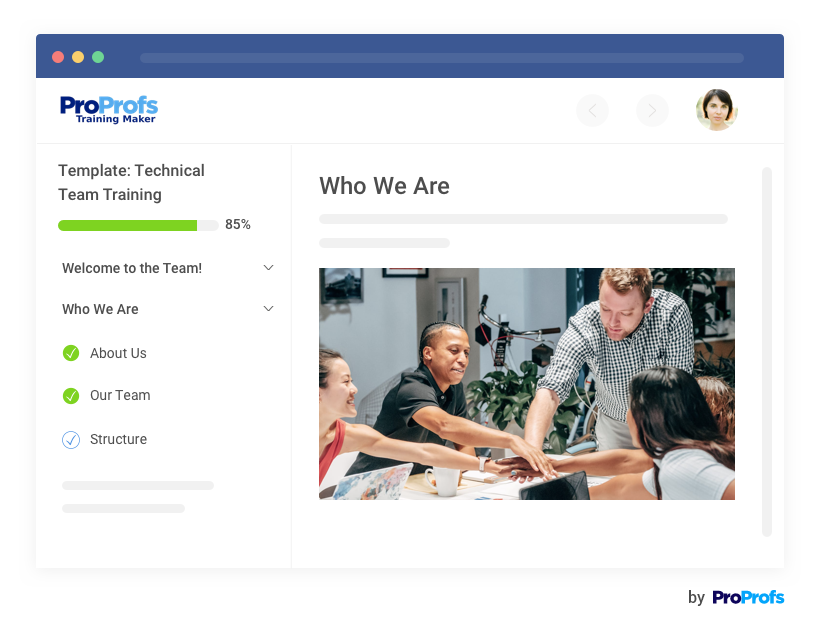
It may be stating the obvious to say that employee training and development is a significant activity across organizations and industries. But that’s because it is.
Perhaps you already have a rough idea of employee training. But to make the most of such programs, you first need to know them inside out or the nuances.
This post discusses all that you should know about the topic so that you can plan and implement impactful online employee training programs.
Let’s get started!
What Is Employee Training?
Employee training refers to the process of developing general and role-based knowledge and skills in employees to help them perform their duties effectively.
Such training programs are often tied to:
- Improved employee performance
- Better decision-making
- Achievement of business objectives
- Adherence to industry standards
Employers use various methods for staff training, including classroom training, eLearning, role-plays, webinars, group discussions, and more.
“Training is not an expense, but an investment. It prepares employees to meet new challenges and equips them with the necessary skills to drive business growth.” – Tony Hsieh, former CEO of Zappos
Pro Tip: Make employee training and development programs engaging, flexible, measurable, and consistent to achieve positive results.
Why Is Employee Training Important?
Employee training provides significant benefits to both employees and organizations. Your employees are your most valuable asset, and by investing in them, you can reap numerous benefits, such as increased productivity and competitive advantage.
Benefits for Employees
Employees who get regular opportunities for learning tend to be more satisfied. It has a cascading effect on all other aspects of their profession.
- Enhanced skills and knowledge
- Career development and growth opportunities
- Increased job satisfaction
- Improved confidence and motivation
- Increased competency in handling challenges
- Better adaptability in dynamic work environments
- Personal and professional growth
- Higher chances of promotions and salary raises
- Improved work-life balance
- Increased job security
Benefits for Organizations
Many employers still don’t invest in their employees’ ongoing formal training. By doing so, they are making a costly mistake. Don’t be one of them. Here are some significant benefits of staff training to organizations that will make you rethink.
- Increased productivity and performance
- Competitive advantage
- Reduced employee turnover
- Enhanced innovation and creativity
- Effective succession planning
- Improved employee engagement and retention
- Alignment with organizational goals and objectives
- Effective risk management
- Enhanced organizational reputation
- Compliance with industry regulations
Case Study: How Access to Counseling delivered simplified and organized training for a large number of employees
Types of Employee Training (With Examples)
There are various types of staff training and development programs. Here are the 12 most common ones:
- Onboarding Training
Onboarding training is the process of integrating new employees into an organization and providing them with the necessary knowledge and skills to perform their job duties effectively. Onboarding training starts with orientation and covers other activities, such as HR paperwork, training on company policies and culture, facility tours, introduction to team members, and role-based training.
Example: Netflix has a structured and comprehensive onboarding program called “The Netflix Culture Deck“. It consists of a 125-page document that outlines the company’s values, expectations, and practices.
The onboarding process at Netflix emphasizes freedom and responsibility. New employees are encouraged to take ownership of their work and contribute their unique insights. Additionally, they are introduced to the company’s culture focused on innovation, collaboration, and continuous learning.
Netflix also assigns a buddy or mentor to each new employee during the onboarding process.
By providing a clear understanding of the company’s values, expectations, and culture, Netflix’s onboarding training sets up new employees for success.
Pro Tip: A learning management system (LMS) can help you automate onboarding and bring your new hires up to speed faster. Many LMS provide professionally designed employee training courses and templates, which saves your time and effort in course creation.
- Technical Skills Training
Technical training imparts the knowledge and skills necessary to succeed in technical fields. The primary goal of technical training is to equip individuals with the competencies needed to perform specific technical tasks or functions within a given industry. In other words, it involves training on all the technical aspects of a job.
Example: The Technical Apprenticeship Program at Microsoft trains individuals with little or no technical background in the areas of software development, cloud computing, and artificial intelligence. Participants undergo an immersive learning experience where they receive hands-on training, mentorship, and real-world project assignments.
The program is highly regarded for its comprehensive curriculum, close collaboration with industry experts, and the opportunity for participants to work on cutting-edge technologies. Through this program, Microsoft has successfully equipped a new generation of professionals with the technical skills needed to thrive in the fast-paced technology industry.
- Soft Skills Training
Soft skills training focuses on developing and enhancing non-technical skills. These skills include communication, teamwork, problem-solving, time management, leadership, adaptability, emotional intelligence, and conflict resolution. The goal is to develop well-rounded professionals who can effectively navigate the challenges of interpersonal relationships.
Example: One example of this training program is the initiative undertaken by PwC.
PwC recognized the importance of upskilling managers and employees in soft skills to meet the challenges posed by disruptions and skills gaps. It implemented leadership programs that focused on developing essential soft skills such as communication, teamwork, and problem-solving.
By investing in soft skills training, PwC aimed to create a work culture that fostered continuous learning and growth for its employees.

- Product or Service Training
Product or service training aims to enhance employees’ understanding of an organization’s products or services and the skills to communicate their values to clients effectively. The training ensures that professionals can effectively communicate, build trust, and instill confidence in customer relationships vis-a-vis a business’ offerings.
Example: Apple’s “Genius Training Program” involves training its retail employees, also known as “Geniuses,” to provide exceptional customer service and technical support.
The program is a rigorous and immersive experience that covers various aspects of Apple’s products, services, and customer interaction. During the program, employees participate in role-playing exercises. They also learn about Apple’s core values, company culture, and the importance of creating a positive customer experience.
This training program has been highly successful and it contributes to Apple’s reputation for excellent customer service.
- Compliance Training
Compliance training focuses on ensuring that employees are knowledgeable about and adhere to all applicable laws, regulations, and policies that govern their organization’s operations. Such training is essential as it helps minimize the risk of legal and financial consequences for organizations. The training can cover a range of employee training topics, such as:
- workplace safety
- anti-discrimination
- harassment prevention
- ethics training
- general data protection regulation
- phishing awareness
- financial regulations
Example: Google places a strong emphasis on compliance and ethical behavior. The search engine giant has implemented a comprehensive training program to ensure that employees understand their legal and ethical obligations.
The training is interactive and utilizes real-world scenarios. Online courses, in-person workshops, and self-paced modules are the common delivery methods.
This compliance training has been highly successful in promoting a compliant culture besides helping maintain a strong reputation and trust among stakeholders.
Pro tip: Use compliance training software to create and deliver customized training modules, track employee progress and completion, and maintain training records. Such solutions also provide automated reminders and notifications to ensure that training is completed on time.
- Sexual Harassment Training
Sexual harassment training is one of the essential and mandated employee training programs. It aims to educate employees on what constitutes sexual harassment in the workplace, how to prevent it, how to respond to incidents, and the legal and ethical implications.
Example: The leading pharmaceutical company Pfizer has taken significant steps to provide training to its employees to prevent and address sexual harassment in the workplace.
The program includes interactive modules, in-person workshops, and scenario-based simulations.
To reinforce the importance of the training, Pfizer incorporates real-life case studies and examples. This helps employees understand the nuances and implications of sexual harassment and provides practical guidance on how to identify, prevent, and respond to such incidents.
Pfizer’s commitment to providing effective sexual harassment training has been recognized with several awards and accolades.
Pro tip: When developing a sexual harassment training program, go beyond addressing legal compliance and focus on changing workplace culture. Ensure that employees understand the importance of respect, consent, and bystander intervention. Creating opportunities for open dialogue.
- Safety Training
While compliance training is about strict compliance with laws and regulations, safety training promotes employees’ safety and well-being in the workplace. It educates them on safety practices and procedures that should be followed to prevent workplace accidents, injuries, illnesses, and even fatalities.
Example: The Share the Road program is a highway safety program of the American Trucking Associations (ATA). It has been active since 1986 and aims to teach the public how to share the road safely with large trucks.
As a part of the program, professional truck drivers who have achieved million-mile accident-free records deliver specific safety tips to drivers, public, media, and public officials. These tips are shared through various channels, including television, radio, the web, and print.
The American Trucking Associations and professional drivers from the Share the Road program often collaborate on initiatives to promote safe driving during busy travel periods, such as Thanksgiving.
- Leadership & Management Training
It is a type of employee training that focuses on developing core leadership and management skills in the workforce. This type of staff training typically includes topics such as communication, delegation, decision-making, and team building. The training is essential for new and experienced leaders, as it can help them build stronger relationships with their team members, improve organizational performance, and achieve business goals.
Example: To provide new leaders with a wider perspective, Paycor has partnered with Miami University’s Farmer School of Business.
The leadership development program integrates the university’s business program content with Paycor-specific training. Senior leaders from the company work with faculty to deliver the program, which introduces upcoming leaders to Paycor’s practices and strategy.
The program concludes with an actual company challenge where leaders participate in problem-solving and present their results to the Paycor committee.
Pro tip: Instead of relying on theoretical presentations alone, create interactive exercises that simulate real workplace situations. This allows employees to practice safety protocols and procedures in a practical setting, making the training more engaging and memorable.
- Quality Assurance Training

Quality assurance (QA) training equips individuals with the necessary skills and knowledge to ensure that products or services meet specific quality standards. The goal of QA is to prevent defects or errors and identify and resolve any issues that may arise during the development or production process. It is a common program in software development, manufacturing, healthcare, automotive, aerospace, and pharmaceuticals.
Example: The Google Testing Blog is an example of an organization’s commitment to QA training. It is a platform where Google engineers regularly share their insights, experiences, and best practices in software testing and quality assurance. The blog covers topics such as test planning, automation, bug reporting, continuous integration, and more. It serves as an excellent resource not only for Google employees but also for the wider software testing community.
- Sales Training
Sales training improves sales professionals’ skills, knowledge, and techniques in selling products or services. This training may include product knowledge, communication skills, persuasion and negotiation tactics, handling sales objections, nurturing sales leads, and closing sales. Some key benefits of this employee development training are increased sales revenue, improved customer satisfaction, better employee morale, and higher professionalism.
Example: Salesforce’s Salesforce University program offers role-specific and hands-on training to sales teams. It is not a one-time event but a continuous learning path. It offers a range of courses for sales professionals at different stages of their careers, ensuring ongoing skill development.
The accessibility of the program ensures that sales teams worldwide can access the training resources and stay aligned with the company’s sales methodologies and best practices.
The program incorporates feedback loops to gather insights from sales professionals about the effectiveness of the training. This feedback is used to refine and improve the program continually.
- Diversity, Equity & Inclusion Training
Organizations often provide diversity, equity, and inclusivity (DEI) training to their employees to promote a positive work environment. The training aims at building a more diverse, equitable, and inclusive workplace. It helps individuals and teams understand and appreciate the value of diversity, reduce bias and discrimination, and create a more welcoming and inclusive environment for everyone. DEI training is becoming increasingly important as more organizations recognize its role in reducing workplace conflicts.
Example: IBM has a long-standing commitment to diversity and inclusion, and its training initiatives are a key part of this approach. It offers various DEI training programs, such as unconscious bias training, which is mandatory for all employees. This training aims to raise awareness of biases and provide strategies for reducing their impact on decision-making and workplace interactions.
What sets IBM’s DEI training apart is its use of innovative technology. Additionally, IBM offers employee resource groups (ERGs) and mentoring programs to support marginalized communities and provide inclusive spaces for networking, support, and career development.
- HR Training
HR training refers to developing and improving the knowledge, skills, and expertise of human resources professionals. This type of training usually covers topics such as recruitment, employee relations, performance management, and leadership development.
The goal of employee training in HRM is to equip individuals with the necessary tools and knowledge to manage human resources within an organization effectively. By investing in HR training, organizations can ensure that their HR professionals have the competencies to contribute to the success of the company. Such training also becomes significant considering the strategic roles HR professionals play these days.
Example: Google trains its human resources professionals, known as People Operations, through a unique and innovative approach. The training process emphasizes continuous learning and development to reinvent the field of HR.
In addition to traditional training methods, Google encourages its HR professionals to collaborate and exchange knowledge through communities of practice and internal networks.
HR professionals at Google leverage the power of people analytics to gather insights and make data-driven recommendations. This approach enables them to understand employees’ needs better, optimize HR processes, and create a more vibrant work environment.

Best Practices for Employee Training
“The only thing worse than training your employees and having them leave is not training them and having them stay.” – Henry Ford
These proven approaches and strategies can empower you to set up and run employee training the right way.
1. Use Relevant Examples
When designing employee training programs, try to use examples relevant to the employees’ roles. By using examples, employees can better understand various key concepts. They will also find the information more relatable, memorable, and applicable to real-world situations.
2. Involve Subject-Matter Experts
Taking the help of subject-matter experts in employee training design and delivery can help ensure that the training is accurate, relevant, and authoritative. Experts can provide valuable insights into industry trends, best practices, and emerging technologies.
3. Use Simulations
Simulations are a great way to provide hands-on experience and allow employees to practice new skills in a safe and controlled environment. Simulations can help employees learn faster and retain more information.
4. Use Research-Based Information
Training programs based on research and best practices are more likely to be effective. By using research-based information, employees can learn from the experiences of others and avoid common mistakes.
5. Incorporate Experiential Activities
Experiential activities, such as role-playing, group discussions, and team-building exercises, can help employees develop new skills and apply the knowledge practically.
6. Blend Delivery Methods
Incorporating different delivery methods, such as eLearning, classroom training, and on-the-job training, can help accommodate different learning styles and preferences. For more on this, read: 8 Tips for Effective Blended Learning Strategies
7. Include Post-Training Activities
Post-training activities, such as follow-up coaching, assessments, performance evaluations, and refresher courses, can help reinforce learning and ensure that new skills and knowledge are applied in the workplace. This approach can also help identify areas where additional training may be needed.
Deliver the Best Version of Employee Training
Employee training and development play a crucial role in the success of any organization. By investing in the growth of your workforce, you can increase productivity, job satisfaction, employee retention, and profitability.
Particularly the types of training programs and the best practices you learned in this post will hopefully help you set up and execute professional, impactful, and measurable workplace learning initiatives.
With a robust cloud LMS, purpose-built courses, strategies, and ongoing support, you can expect significant returns from employee training.
The idea is to build a winning team that aligns its activities with your business goals.
If you need employee training software and relevant courses on onboarding, skills, safety, compliance, HR, and sales, help is just around the corner.
Go for a test drive or request a personalized demo today!
Do you want a free Training Software?
We have the #1 Online Training Software for employee training & assessment









